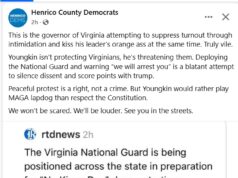The following highlights and press release are from Dr. Rachel Bitecofer’s new report on the Virginia 2019 legislative elections and from CNU’s Wason Center for Public Policy. Let’s start with the highlights (bolding added by me for emphasis; notes by me in parenthesis and italics following the quotes from Bitecofer’s analysis):
- “With two post-Trump elections behind them, both of which had produced large turnout surges for Democrats and sympathetic Independents aligning with Democrats, Republicans already faced an uphill battle defending their General Assembly majorities this year. Then, the federal courts struck down 11 House of Delegates districts due to racial gerrymandering. The court-ordered revisions affected the boundaries of 25 districts and made additional Democratic Party pick-ups even more likely. Several Republicans strategically retired.” (Agreed; the Bethune-Hill case was crucial, which is why Republicans fought so hard to maintain their racial gerrymandering.)
- “Turnout in the 2015 cycle was low at 29.1% of registered voters, a typical turnout rate for the off-, off-year cycle. Turnout varied widely by district, ranging from 10% to 40%, according to this recent analysis from the Virginia Public Access Project. Over the Obama era, low turnout generally benefited the Republican Party, whose own voting base tends to be older and predominately white — two demographic groups with less variance in their turnout than other demographic groups.” (See my analysis, What Happens if Virginia Dem Turnout in 2019 Reverts More to Normal, Historical Patterns for Odd/Off-Year Elections?)
- “In the polarized era, as more voters have sorted into the two political parties ideologically, with liberals in the Democratic Party and conservatives in the Republican Party, turnout of each party’s loyal constituencies has become more important in terms of deciding which party will prevail on Election Day…The small portion of each electorate who are “pure” Independents are top targets for each campaign, and “persuadable” within reason…” (Agreed; I’ve been saying this for a long time now.)
- “The dramatic transformation of the Democrats’ fortunes in legislative races in Virginia…These voters [college-educated women; millennials and Gen Z voters; minority voters; and Independents who “lean” left or at least don’t “lean” right]…have been galvanized to the polls via negative partisanship because of the election of Donald J. Trump. Trump has shaken into action a sleeping demographic giant in Virginia.” (Sad that it took an unmitigated, massive disaster like Trump to do this, as people should *always* care about their local and state legislative elections and of course should *always* vote!)
- “A big unknown for the 2019 cycle is whether this Democratic turnout surge will manifest in an election cycle lacking any statewide stimulant. Will there be a natural “Trump Bump” for Democrats when there is only low-salience, district-specific campaign activity? If so, how large a bump should we expect? What is not unknown is Republican turnout. At the very least, Republicans will replicate their 2015 turnout, and my forthcoming analysis of Virginia’s competitive House of Representatives districts in 2018 suggests that the GOP may even see improvements over their 2015 turnout. Despite controlling the White House, the Republican base posted strong voter turnout numbers in 2018 in support of Republican candidates for Congress.” (Agreed, we can’t assume that Rs will stay home.)
- “Democrats still have some “low hanging fruit” left from the 2017 cycle. Del. Tim Hugo’s seat in House District 40 in Northern Virginia came within 100 votes of flipping in 2017. Most famously, Democrats lost the 94th House District in Hampton Roads in a “drawing for lots” after a recount produced a tie. But the 94th is one of the many districts affected by the court-mandated new maps. The result was catastrophic for the GOP. Of the 25 districts redrawn, 8 of the 9 held by Republicans became friendlier for Democrats. Of these, 4 went from fairly “safe” Republican seats to competitive seats, and the 94th went from an electorate that produced a tie in 2017 to one that decisively favors Democrats, leaving the Republican incumbent on the fence as late as August as to whether to run or not. Although the redistricting also made several districts less friendly for Democrats, in only one district, the 93rd, does the change feasibly create a pick-up opportunity for Republicans, although even that district maintains a modest Democratic advantage.” (Note that Tim Kaine won HD40 by 19 points last year, and Ralph Northam by 11 points in 2017)
- “It is worth noting that one of the districts most severely impacted by the redistricting belongs to Republican House Speaker Kirk Cox. As seen in Table 2, the speaker’s district has moved from being a completely safe district (R+14) to a toss-up (R+1.6).” (To read about the Democrat who’s fighting to unseat Cox, see Saturday Night, I Saw a Much Better Political Future for Virginia Flash Before My Eyes, and Her Name Is Sheila Bynum-Coleman)
- “Virginia PVI scores should give us a reasonable sense of how competitive each of the 2019 races will be and, in my opinion, should be the single most important predictive factor as to what results we can expect. PVI scores will be more important than incumbency, fundraising, personality, or other factors people generally cite to ‘explain’ election results.” (Generally, I agree, although certainly incumbency, fundraising, etc. are important.)
- “Democrats need a net pick-up of at least 2 seats in each chamber to have a working majority. And although Virginia politics is not as marked by gridlock and polarization as its federal counterpart across the Potomac, failure to flip only one of the chambers and not the other is likely to produce continued legislative stalemates for Virginia Democrats’ most sought-after legislative goals, such as gun control, minimum wage increase, and voter rights reforms.” (Yes, the stakes are very high on November 5 – for everything we care about.)
- “What we do know is that turnout in this cycle, as in all elections in the polarized era, will be decisive. Whichever side best motivates the voters that make up their party’s coalition will prevail on Election Day. Democrats, it appears, seem content to rely on a natural “Trump Bump” they feel no need to energize directly.” (And yes, it’s all about motivating the people who turned out in 2017 and 2018 to vote Democratic to turn out against this year, with no statewide or federal race on the ballot.)
- “Virginia Republicans find themselves facing the same electoral conundrum that has plagued them in every election cycle since Donald Trump captured the presidency. They must embrace a highly visible party figurehead their base voters adore but the rest of their potential voters hate, including a solid majority of Independents.” (Thus, the hysterical, wild, over-the-top Republican charges that supposedly if Democrats take back control in Virginia, all manner of disasters will unfold. Of course, it’s complete and utter horseshit, but it *might* work to motivate the Republican base.)
- “So, What Will Happen? Press speculation is that Democrats are more bullish on their potential to pick up the state Senate than they are the House of Delegates. Assuming this reporting is on target, I am having a hard time squaring this assessment with the data… even if Democrats were to lose some of the House seats they gained in the 2017 cycle (the 10th, 68th, and 85th would be most likely), they would still have viable paths to a House majority because several districts that once had Republican PVIs now have Democratic ones. Two of these, David Yancey’s district (the 94th, which ended in a tie in 2017) and Chris Jones’ district (the 76th) seem primed to flip to Democrats under even the most modest Democratic turnout surge models. That said, a good Election Day for Democrats hinges on at least some Trump Effect (turnout surge) in 2019. Even with the benefits of the court-ordered redistricting, if the electorate looks like it did in 2015 in terms of its partisan composition, Democrats will come up short of a majority and may even lose ground. Still, it’s hard to imagine a scenario in which this happens...Based on my conversations with Democratic Party insiders, the party understands that base turnout is the key to victory in the 2019 cycle and is structuring their GOTV efforts accordingly…The simple fact is, if Democrats want to win, they need to outvote Republicans.” (Check out Graphics: Turnout by Virginia State Senate, House of Delegates District in the Last Off/Odd Election Year – 2015)
- ” If ground zero of 2017 was NOVA, ground zero of 2019 is Hampton Roads, where voter turnout traditionally favors the GOP.”
- “Political campaigns are built to take things out of context, and Northam’s gaffe has become a rallying cry to mobilize Republican base voters to the polls, not only here in Virginia but across the country in the 2018 midterms and in the upcoming 2020 cycle…However, no matter how good the Republican strategy is, they will be overwhelmed if Democrats show up in increased numbers… There are simply too many swing districts with conditions ripe for a Democratic Party turnout surge.“
- “…the most interesting and competitive races, which I at this point expect to be House districts 10, 40, 21, 28, 50, 51, 66, 68, 72, 83, 84, 85, and 91 and Senate districts 7, 8, 17, and 27.” (Compare and contrast to Ben “Not Larry Sabato” Tribbett’s and Chaz Nuttycombe’s latest House and Senate ratings. I’ve asked Prof. Bitecofer about SD27, which I presume is a typo, since it’s a deep-red district. I presume she meant SD12 (and I guess she’s saying that Dems will take back SD10 and SD13, ergo not “interesting and competitive?”). Also, I’d add in HD27 – Larry Barnett vs. Roxann Robinson – for sure as competitive. And definitely HD73 – Rodney Willett vs. Mary Margaret Kastelberg. And obviously HD94 – Shelly Simonds vs. David Yancey. And HD100 – Phil Hernandez vs. Rob Bloxom. UPDATE 10:24 am: After I informed her of the mistake re: SD27, Bitecofer corrected it to “Senate districts 7, 8, 12, and 17”)
- “Turnout is too unpredictable If overall turnout exceeds 31%, November 5 is likely to be a good day for Democrats.” (The higher the turnout, generally speaking, the better for Dems. As the saying goes, when we vote…we win!)
- “I highly recommend that you nevertheless follow these statehouse races closely for what they will indicate about 2020. First, and foremost, either a great day or a bad day for Democrats will tell us a lot about the energy in the Democratic Party heading into 2020 cycle. Second, a decent day, a day on which Democrats hold their previous gains but come up short on gaining majority control will demonstrate the folly of not tapping directly into the Trump referendum effect. Flipping both chambers is something Democrats should be able to achieve, and failure to do it would be attributable to their strategic choice to gamble on a natural surge.” (Agreed – Dems absolutely need to explain why voting in these state legislative elections matters not just for Virginia, but in terms of “resisting” and sending a loud message to Trump!)
Virginia’s November legislative election previews 2020 presidential election, as ‘Negative Partisanship’ applies to General Assembly at a tipping point
The Wason Center for Public Policy at Christopher Newport University has posted Dr. Rachel Bitecofer’s initial preview of the Nov. 5 Virginia legislative election. Not only is control of the General Assembly at a tipping point, but, looking to the 2020 presidential election, the state contest will be a telltale indicator of which party’s voters are more energized in this hyperpartisan era.
Among the questions she addresses:
– Are Virginia Democrats better off maximizing the anti-Trump energy or campaigning only on issues such as health care and education?
– With Virginia Republicans also stirred up by national partisan fights, will their usual turnout advantage in an election with no statewide candidates preserve their majority?
Four months before the 2018 midterm Blue Wave, Dr. Bitecofer’s innovative “Negative Partisanship” model predicted almost to the seat the Democrats’ gain in the House of Representatives. In this analysis, she applies her theory to the competitive districts in the Virginia House of Delegates and Virginia Senate, ranking each according to its partisan advantage.
Dr. Bitecofer’s work has been featured in The New York Times, The Washington Post, The Cook Political Report, MSNBC and other state, national and international media outlets.














![After a Terrible Week, Some Wise Thoughts by VA State Sen. Danica Roem on “vacillat[ing] between dejection and anger in a ‘Is this really the best we can do? Is this where we’re at? Why the hell is everything so broken?’ sort of way.”](https://bluevirginia.us/wp-content/uploads/2025/09/danicalatenight-100x75.jpg)